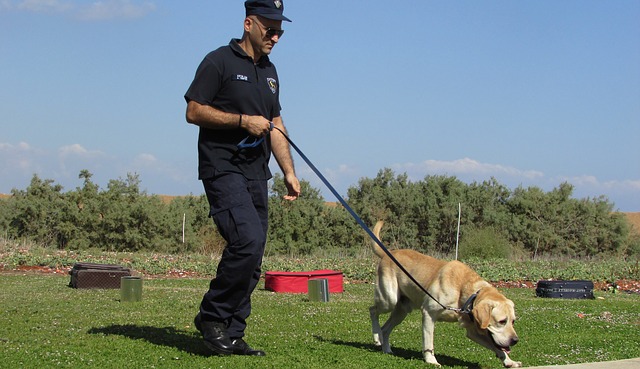- Earn your Dog Obedience Trainer certification in as little as 5 months.
- Study online at your own pace.
- Affordable tuition and flexible payment options.
- Nationally accredited college.
You may think about becoming a dog obedience trainer, but you wonder what it entails.
You have to understand that a dog trainer is a very important person to dog owners.
They help owners learn how they can:
- Interact with their dogs
- Get them to behave
So here’s everything you need to know about this great profession.
- Job Description
- Salary
- How to Become
- Education
- Certification & Licensing
- Popular Programs
- Job Outlook
- Should You Become
- FAQs
- Info by State
- Similar Careers
What Does a Dog Trainer Do?
A dog trainer is the bridge between dogs and their owners to establish trust and communication.
That’s why you should do your best and undergo extensive training to be able to help them.
To effectively do this, you must first identify the dog’s problem.
It is usually an issue that’s behavioral in nature.
Once you do, you can then create a fitting training plan to correct that behavioral problem.
Only then can you be able to coach owners appropriate obedience techniques.
Duties
At a minimum, you will be responsible from basic obedience training to more advanced.
Your duties will include, but not limited to:
- Basic obedience for the older dogs
- Puppy training
- Obedience training for competition
- Special training for search and rescue
- Teaching a dog how to interact with their owner
- Positive reinforcement and reward systems
- Clicker training
- Verbal cues and hand signals
- Communicating with owners
- Assigning homework to owners
How Much Does a Dog Trainer Make?
This is a common question that a lot of people interested in this career ask.
On average, animal trainers will earn an annual salary of $34,541.
The minimum income you can earn is $18,324.
And if you’ve gotten more skilled and accumulated experience, it can go up to $59,304.
This is roughly $8.81 to $28.51 per hour, with an average rate of $16.60 per hour.
But this number can still vary depending on several factors, such as:
- Education
- Experience
- Type of training you do
- Size of the company you work at
- Where you live and work
Average National Salary: $34,541
Salary Information by State
| State | Employed | Avg. Annual Salary | Avg. Hourly Pay | Top 10% Annual Salary | Bottom 10% Annual Salary |
|---|---|---|---|---|---|
| Alabama | 220 | $52,820 | $25.39 | $69,620 | $30,250 |
| Alaska | 80 | $35,550 | $17.09 | $42,000 | $29,630 |
| Arizona | 710 | $37,170 | $17.87 | $54,070 | $30,400 |
| Arkansas | 200 | $46,400 | $22.31 | $60,980 | $28,680 |
| California | 2,470 | $56,800 | $27.31 | $84,250 | $36,490 |
| Connecticut | 380 | $49,390 | $23.74 | $66,120 | $34,930 |
| Delaware | 90 | $39,120 | $18.81 | $56,840 | $29,470 |
| District of Columbia | ** | $39,240 | $18.86 | $48,310 | $36,310 |
| Florida | 1,570 | $42,750 | $20.56 | $71,990 | $25,370 |
| Georgia | 790 | $39,760 | $19.12 | $47,840 | $28,230 |
| Hawaii | 90 | $59,320 | $28.52 | $77,780 | $33,110 |
| Idaho | 130 | $36,810 | $17.70 | $42,710 | $31,200 |
| Illinois | 550 | $38,180 | $18.36 | $52,710 | $29,650 |
| Indiana | 560 | $42,940 | $20.64 | $62,590 | $29,830 |
| Iowa | 120 | $44,350 | $21.32 | $55,150 | $31,060 |
| Kansas | 230 | $37,640 | $18.09 | $50,010 | $25,250 |
| Kentucky | 310 | $36,450 | $17.53 | $56,190 | $24,300 |
| Louisiana | 170 | $34,260 | $16.47 | $46,520 | $28,290 |
| Maine | 50 | $40,220 | $19.34 | $56,060 | $34,190 |
| Maryland | 600 | $53,470 | $25.71 | $77,120 | $31,510 |
| Massachusetts | 240 | - NA - | - NA - | - NA - | - NA - |
| Michigan | 590 | $36,140 | $17.38 | $51,500 | $23,190 |
| Minnesota | 520 | $38,750 | $18.63 | $48,360 | $31,510 |
| Mississippi | 50 | $39,430 | $18.96 | $52,610 | $30,310 |
| Missouri | 600 | $37,230 | $17.90 | $54,360 | $25,580 |
| Montana | 60 | $43,900 | $21.11 | $56,830 | $33,350 |
| Nebraska | 80 | $35,910 | $17.27 | $45,200 | $31,800 |
| Nevada | 160 | $37,790 | $18.17 | $46,750 | $28,720 |
| New Hampshire | 140 | $39,670 | $19.07 | $57,140 | $26,840 |
| New Jersey | 340 | $58,670 | $28.21 | $82,440 | $34,870 |
| New Mexico | 100 | $38,250 | $18.39 | $47,950 | $29,420 |
| New York | 1,320 | $51,470 | $24.75 | $90,930 | $34,600 |
| North Carolina | 740 | $46,960 | $22.58 | $80,820 | $24,960 |
| North Dakota | 50 | $39,770 | $19.12 | $67,180 | $30,370 |
| Ohio | 970 | $38,160 | $18.35 | $60,770 | $26,380 |
| Oklahoma | 170 | $40,930 | $19.68 | $69,260 | $20,850 |
| Oregon | 230 | $49,680 | $23.88 | $66,560 | $33,130 |
| Pennsylvania | 630 | $44,310 | $21.31 | $59,210 | $30,990 |
| South Carolina | 190 | $38,780 | $18.64 | $62,140 | $21,560 |
| South Dakota | 60 | $39,040 | $18.77 | $50,530 | $29,120 |
| Tennessee | 310 | $46,000 | $22.12 | $86,450 | $30,760 |
| Texas | 790 | $34,810 | $16.73 | $52,590 | $18,240 |
| Utah | 260 | $34,270 | $16.47 | $49,850 | $21,060 |
| Virginia | 620 | - NA - | - NA - | - NA - | - NA - |
| Washington | 570 | $49,560 | $23.83 | $59,040 | $35,520 |
| West Virginia | 150 | $46,440 | $22.33 | $73,430 | $28,950 |
| Wisconsin | 420 | $44,520 | $21.40 | $62,620 | $29,920 |
Annual Average Salary: Top 10 States
The top earning state in the field is Hawaii, where the average salary is $59,320.
These are the top 10 earning states in the field:
* Employment conditions in your area may vary.
Step-by-Step Guide to Becoming a Dog Trainer
Step 1 Get Yourself a Dog
It’s much easier to gain dog training experience when you have a dog yourself.
This way, you can learn the responsibilities that come with being a pet owner.
It also allows you to navigate your way into understanding a dog’s needs at a much personal level.
For instance, you will know the reasons why a dog suffers separation anxiety.
Or why certain breeds are independent, while some are attached to their owners.
If for some reason you can’t own a dog, then you can also volunteer at either:
- An animal shelter
- A dog kennel
Pet sitting for your friend or even neighbors can also be an option.
Step 2 Take Some Dog Training Courses
Dog trainers usually enroll:
- At a technical or community college
- Through organizations
These institutions often offer you more generalized training courses.
Of course, there are specialized courses as well, such as training service dogs.
The good news is that these courses don’t have any special requirements.
They’re open to everyone interested.
You only have to pay a fee.
To advance your career, it’s helpful to get a degree in animal care for more in-depth learning.
Step 3 Get Your Dog Trainer Certification
Outside of the K9 units in the police departments, this step is voluntary.
You may or may not get certified.
But some companies may require you to get one from accredited organizations like the Certification Council for Professional Dog Trainers (CCPDT).
Getting this certification can help you gain more recognition and increase employment options.
Step 4 Decide on a Dog Training Specialty
There are a lot of dog trainers capable of basic dog training.
But few can specialize in one area and be an expert in it.
Having a dog training specialty means you only have to focus on one advanced dog training.
For instance, behavioral correction training.
Not to mention that you will have a more tight customer niche.
Some areas you can specialize in are:
- K9 dog training
- Service dogs for persons with disabilities
- Dog performance
- Hunting
- Puppy obedience training
Step 5 Continuing Education to Advance Your Career
You won’t stay an employed dog trainer your whole life.
You will want to advance, and opening your own dog training business is the best way to do it.
It can open up more learning opportunities for you, like capturing new market segments.
More so when you offer special services like the ones mentioned above.
So take business-related courses and gain knowledge on matters on:
- Marketing
- Sales
- Retail management
In effect, you will be able to:
- Find and retain new clients
- Expand into new fields like grooming
- Maximize your business potential
A degree in animal care is also an option if you want to pursue technical studies.
The knowledge you gain from it can also be your advantage in career advancements.
Find Schools »Education Needed to Become a Dog Trainer
Becoming a dog trainer has no set formal education.
But it’s best for you to have earned your high school diploma or its GED equivalent.
This will make it easier for you to get a certification should your employer require it.
Even though you don’t need to go to college, you do need to enroll in an established training program.
Here you will acquire the following necessary to become a professional dog trainer:
- Sufficient knowledge
- Better understanding
- Hands-on experience
Training programs usually last from six to 12 months.
Mostly because training depends upon the type of certification you want to get.
Here’s a video from a seasoned dog trainer to give you some insights into this profession.
Video About The Career
Certification and Licensing
Even though it’s not mandatory, having a certification does have its advantages.
It can:
- Make clients trust you more
- Give you more prestige
- Open up job opportunities
CCPDT is one of the well-known organizations that offer accredited certifications.
- Knowledge Assessed (CPDT-KA)
- Knowledge and Skills Assessed (CPDT-KSA)
To be eligible for CPDT-KA, you must have:
- At least 300 hours of dog training experience within three years
- A recommendation from a vet or CCPDT professional
To be eligible for CPDT-KSA, you only have to be a KA certification holder.
In both cases, CCPDT requires you to pass their examination.
And to keep your certification, you must pursue continuing education.
Average Training Program Duration: 6-12 Months
Popular Programs
Get your accredited and budget-friendly associate degree or career diploma entirely online!
Veterinary AssistantVeterinary TechnicianVet Office ManagerDog ObediencePet GroomingSponsored Online Programs.Job Outlook and Growth for Dog Trainer
Per the latest data from the U.S. Bureau of Labor Statistics, the job outlook for dog trainers will grow up to 28% by 2030.
This growth can be attributed to the following:
- The way people are willing to spend more on animal care than in previous years
- Many trainers planning on retiring or changing to another profession
Nonetheless, this doesn’t change the fact that the future for dog trainers is good—better even.
And we can already see and feel that with the number of people searching for dog trainers increasing.
For instance, the demand for trainers to help service animals companies.
Trainers who care for animals and educate owners will always be in demand.
Employment Growth Projection: 6%
2023
2033
That's a higher than average projected growth of 3,700: Interest Over Time
Should You Become a Dog Trainer?

Overall Satisfaction: High
Dog trainers love their work because they love:
- Working and interacting with animals
- Helping people, especially those in need of service animals
- Assisting dog owners interact with their pets
Seeing how well the dogs and owners do during training gives any dog trainer a true sense of satisfaction.
It’s truly a job well done!

Average Salary: Medium
The money you make depends on several factors like:
- Experience you have
- Type of training you received
- Where you work
- Certification you hold
But on average, your annual average salary will be $34,541.
Roughly, that’s an average of $16.60 per hour.

Job Growth Outlook: High
With a projected growth rate of 28% by 2030, you can expect a high demand for dog trainers in the next few years.
This mainly stems from people willing to spend more on:
- Their dogs’ welfare
- Improving their owner-pet relationship
So expect more clients looking for you, especially those from law enforcement and service animals companies.

Education Duration: 6-12 Months
Dog trainers don’t need formal training or certification to work as one.
But enrolling in a training program can help your career greatly.
Training and certification initially take six months to a year to complete.
Many trainers go on to further their education.
They aim to learn how to train specialized dogs, such as drug detection dogs or guard dogs.

Personal Skills Needed
Becoming a dog trainer requires many skills you have to master.
Or at least, be good at it.
Good coaching skills
You’ll need to be able to motivate clients through tough and easy times.
Emotionally perceptive
Training is taxing.
So you’ll have to have the ability to sense your client’s emotional needs and try to soothe them.
Show compassion, kindness, and empathy.
Excellent communication
You can relay well what you want to say and listen intently to understand what the client wants.
Lots of patience
You should be able to bear the repetitive tasks in training dogs until they’re able to learn your teachings.
Knowledge of human psychology
People learn differently.
By knowing and understanding your clients, dog and man, you can customize a training course suitable for them.
Frequently Asked Questions
Q. How long does it take to become a dog trainer?
Since it doesn’t require any type of certification, it doesn’t take long to become a dog trainer.
Training often takes six months to a year.
Q. How much does a dog trainer make?
Dog trainers earn an average of $34,541 per year.
If you want to make more, then brush up on your:
- Skills and experience
- Training
Don’t forget to maintain your eligibility for certification as well.
Q. What can a dog training certificate get you?
Some people think that getting a dog training certificate isn’t worth it.
After all, they can still work without one.
But earning a dog training certificate can open up many opportunities, such as:
- Help you get more clients
- Show your credibility
- Ability to work in other places
Q. What does a dog trainer do on a daily basis?
As a dog trainer, you usually have to apply many techniques to help improve the dog’s behavior.
You’ll do:
- Operant conditioning
- Desensitization
- Positive reinforcement
- Clicker training
- Hand signals
- Verbal cues
- Reward systems
- Communicate with the owners
- Assign homework
- Work with service dogs
- Lead classes for dogs and owners
Q. Where do dog trainers work?
Most trainers are self-employed, with some working as head trainers in a training program.
At times, they also help out the police department and/or service dog companies.
Meanwhile, some of them are employed in:
- Veterinary clinics
- Boarding kennels
- Animal shelters


